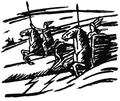|
Eir In Norse mythology, Eir (Old Norse: [ˈɛir], "protection, help, mercy"[1]) is a goddess or valkyrie associated with medical skill. Eir is attested in the Poetic Edda, compiled in the 13th century from earlier traditional sources; the Prose Edda, written in the 13th century by Snorri Sturluson; and in skaldic poetry, including a runic inscription from Bergen, Norway from around 1300. Scholars have theorized about whether these three sources refer to the same figure, and debate whether Eir may have been originally a healing goddess or a valkyrie. In addition, Eir has been compared to the Greek goddess Hygieia. AttestationsPoetic EddaIn the Poetic Edda poem Fjölsvinnsmál, the watchman Fjölsviðr presents a list of the maidens that attend the lady of the keep—Menglöð—that includes Eir, and states that they all sit on the hill Lyfjaberg (Old Norse "hill of healing"[2] or "healing mountain"[3]). The exchange between the hero Svipdagr and Fjölsviðr mentioning Eir is as follows:
After the exchange, Svipdagr asks if these figures will give aid if blót are made to them. Fjölsviðr responds that Svipdagr is correct:
Prose EddaIn chapter 35 of the Prose Edda book Gylfaginning, the enthroned figure of High provides brief descriptions of 16 ásynjur. High lists Eir third, and says no more about her other than noting that "she is an extremely good physician."[7] In chapter 75 of the Prose Edda book Skáldskaparmál Eir appears within a list of valkyrie names, but Eir is not included in the list of ásynjur in the same chapter.[8] Skaldic poetry and runic inscriptionIn skaldic poetry, the name Eir is frequent in kennings for women. A sample construction is Eir aura ("Eir of riches"), occurring in Gísla saga.[9] The name is already used in this way by the 10th century poets Kormákr Ögmundarson and Hallfreðr vandræðaskáld.[10] Similarly, the name Eir is used in a woman kenning in a runic inscription inscribed on a stick from Bergen, Norway around the year 1300. The stick records a common mercantile transaction followed by a verse from a displeased scribe (edits applied per the translator's notes): Mindy Macleod and Bernard Mees posit that the first line of the inscription essentially means "women make me miserable" or potentially "marriage makes me miserable," whereas the second line means "women often take a lot of sleep from me."[11] The name remained frequently used in woman kennings in rímur poetry.[12] TheoriesRegarding the seemingly three different, seemingly conflicting, mentions of Eir, Andy Orchard says that the etymology of the name Eir may appear to fit the role of Eir as a goddess and servant of Menglöð best, but that one should consider that the valkyries also have the ability to waken the dead.[13] John Lindow is skeptical of there having been a belief in Eir as a goddess, stating that "whether we should trust Snorri and imagine the existence of a goddess Eir is problematic".[14] Rudolf Simek says that Eir may originally have been simply a valkyrie rather than a goddess, and lists the servant of Menglöð by the same name as a separate figure.[15] Hilda Ellis Davidson comments that "virtually nothing" is known about Eir outside of her association with healing, and points out that she is "singled out as one of the Norns who shape the lives of children". Davidson adds that "no satisfactory conclusions" have been drawn from her name, and considers all mentions of Eir as of the same figure. Davidson says that, in reference to Eir's appearance among Menglöð's maidens, that the names of these maidens "suggest that they are guardian spirits, and [they are] said to 'shelter and save' those who make offerings of them. They could be akin to protective spirits of the house, guarding both men and women." She additionally draws a link between these spirits and Lyfjaberg:
Henry Adams Bellows proposes a relationship between Eir and the place name Lyfjaberg, which he translates as "hill of healing". Bellows notes that manuscripts vary about the spelling of the place name, and that he, like others, has followed 19th-century scholar Sophus Bugge's choice. Bellows states that the stanza mentioning Lyfjaberg "implies that Mengloth is a goddess of healing, and hence, perhaps an hypostasis of Frigg, as already intimated by her name [...]. In stanza 54, Eir appears as one of Mengloth's handmaidens, and Eir, according to Snorri (Gylfaginning, 35) is herself the Norse Hygeia. Compare this stanza to stanza 32."[2] Notes
References
|
